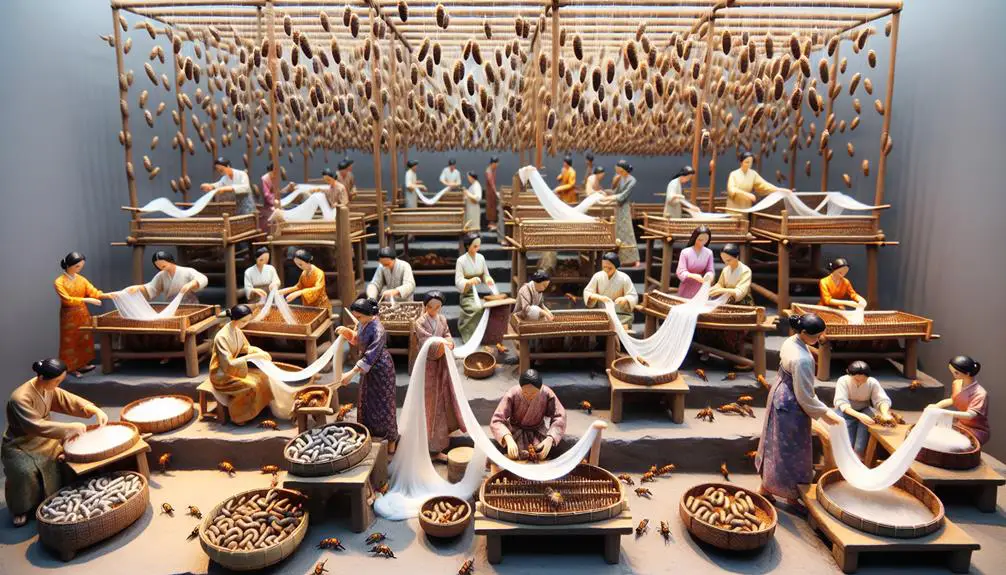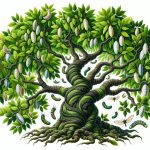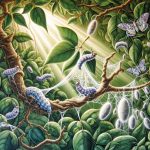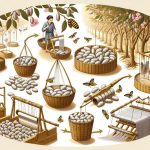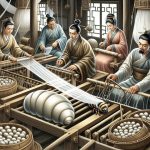I can tell you that silk is the shimmering thread spun by silkworms to create cocoons, a luxurious natural fiber known for its opulence and refinement in textile craftsmanship. It originated in China during the Neolithic period, primarily composed of fibroin. Pioneer Chinese silk production involves nurturing silkworms on mulberry leaves. Luxurious and strong, silk revolutionized the textile industry, famous for its sheen and durability. If you're curious about its characteristics, applications, and cultural significance, you'll uncover a rich history worth exploring further.
Table of Contents
Key Takeaways
- Silk is a natural protein fiber.
- Silk is primarily composed of fibroin.
- The primary source of silk is the Mulberry silkworm.
- Silk has a luxurious texture and natural sheen.
- Silk is a sought-after fabric for high-quality garments.
Silk Origins
Silk, originating in China during the Neolithic period, is a natural protein fiber primarily composed of fibroin. The Chinese are credited with being the pioneers of silk production through the practice of sericulture.
The mulberry silkworm, which spins its cocoon from silk fibers, is the primary source of silk used for textiles. This ancient tradition of cultivating silkworms for their valuable silk has been passed down through generations, shaping the history of Chinese craftsmanship and trade.
The origin of silk production in China dates back to a time when the luxurious fabric was a closely guarded secret, with the Chinese going to great lengths to maintain a monopoly on silk textiles. The intricate process of rearing silkworms, harvesting their cocoons, and carefully spinning the silk fibers into threads showcases the meticulous attention to detail that defines Chinese silk production.
The legacy of Chinese sericulture continues to be revered worldwide for its exquisite silk products.
Silk Production
Originating in ancient China during the Neolithic period, the production of silk revolutionized the textile industry and became synonymous with luxury and elegance. Silk is primarily composed of fibroin, a natural protein fiber obtained from the cocoons of the mulberry silkworm larvae. The production process involves nurturing silkworms on mulberry leaves until they form cocoons, which are then harvested and unraveled to obtain the silk fibers.
Chinese silk, historically reserved for the Emperors of China, eventually spread through Chinese culture and trade, becoming a highly sought-after commodity. The silk industry played a pivotal role in ancient economies, with Chinese silk being traded along the famous Silk Road to regions like the Indian subcontinent, the Middle East, Europe, and North Africa. The intricate production methods and high-quality silk fabrics contributed to the reputation of Chinese silk as a symbol of wealth and sophistication. The silk trade flourished, with ancient tombs revealing finely woven and dyed silk textiles dating back thousands of years.
Silk Characteristics
Characterized by its luxurious texture and natural sheen, silk is a natural protein fiber renowned for its breathability and durability. Composed mainly of fibroin, a strong and resilient protein, silk is produced by silkworms as they weave cocoons from the protein they secrete. The shimmering appearance of silk is a result of its triangular prism-like structure that reflects light in a unique way, giving it an unmatched elegance.
Silk's luxurious texture and natural sheen make it a sought-after fabric for high-quality garments and luxurious home textiles. Despite its delicate appearance, silk is surprisingly strong and durable, with fibers that can withstand tension and bending without losing their integrity. Additionally, silk is highly breathable, making it a comfortable choice in various climates. Its ability to regulate body temperature and wick away moisture adds to the allure of silk as a premium fabric.
Authentic Silk Testing
Moving from understanding the key characteristics of silk, it's essential to grasp the methods employed in authenticating the genuineness of this luxurious fabric. Authentic silk can be distinguished by its natural sheen, which results in distinctive light reflection. One common method to test for real silk is the burn test. When performing a burn test on silk fibers, a genuine sample should give off a burnt hair odor and leave behind fine ash residue.
Moreover, genuine silk may exhibit slight irregularities in its fibers, such as variations in thickness. These imperfections can actually indicate the authenticity of the silk, as synthetic materials often lack these natural inconsistencies. Additionally, when examining silk fabrics, look for soft and luxurious textures. These textures are characteristic of real silk and can help in distinguishing it from synthetic alternatives. By paying attention to these details in sheen, burn tests, irregularities, and textures, one can successfully authenticate the quality of silk.
Silk Applications
I'll start by discussing the various silk applications, including its use in consumer apparel like scarves, shirts, and lingerie.
Additionally, silk is utilized in home decor items like pillows and curtains.
In the industrial sector, silk finds its place in parachute manufacturing and surgical sutures.
Silk Fabric Types
Silk fabric types encompass a range of luxurious and durable options, each with unique characteristics and applications.
- Mulberry Silk is known for its luxurious texture and sheen, being the most widely produced type of silk fabric.
- Eri Silk, also called peace silk, is heavy and durable, suitable for various applications.
- Tasar Silk, a wild silk from India, is the second-most produced type with unique characteristics.
- Spider Silk, primarily used for industrial purposes, is rare and strong, hence expensive.
- Muga Silk, produced exclusively in Assam, India, is semi-domesticated and highly valued for its distinct properties.
These silk varieties offer a diverse range of options for different uses, from high-end textiles to specialized industrial applications.
Silk Production Process
The silk production process involves cultivating silkworms, hatching them into larvae, and nurturing them through their cocoons before extracting and weaving the luxurious fibers.
Silkworms feed on mulberry leaves to create their cocoons, which are then carefully harvested before the moths emerge. These cocoons are boiled to extract long silk fibers, which are then unwound, twisted, dyed, and woven into the sought-after luxury fabric known as silk.
This exquisite material finds applications not only in apparel and home decor but also in various industrial uses due to its exceptional properties. From its humble beginnings with silkworms to the weaving of the final product, the silk production process is a blend of tradition and innovation that yields a versatile and coveted fabric.
Silk Sustainability
Silk sustainability is an essential aspect of the textile industry, and it's something I'm passionate about.
Eco-friendly silk production methods are gaining popularity due to their minimal environmental impact.
Initiatives like silk recycling further emphasize the benefits of silk beyond its luxurious feel.
Eco-Friendly Silk Production
When aiming for eco-friendly silk production, the focus lies on minimizing environmental impact throughout the manufacturing process. Sustainable practices are key to reducing the ecological footprint of silk production.
Here are some essential aspects of eco-friendly silk production:
- Minimize Chemical Usage: Using fewer chemicals helps preserve the environment and reduces health risks for workers.
- Promote Biodiversity: Supporting diverse ecosystems around silk farms enhances natural resilience and sustainability.
- Fair Labor Practices: Ensuring fair wages and safe working conditions for silk industry workers is vital for ethical silk production.
- Animal Welfare: Respecting the well-being of silkworms and other animals involved in silk production is crucial for sustainability.
- Environmental Impact: Evaluating and mitigating the overall impact of silk production on the environment is a continuous effort.
Benefits of Silk
Minimizing environmental impact and promoting sustainability are inherent benefits of choosing silk as a natural fiber option. Silk, a renewable material, is produced through non-toxic processes that guarantee minimal harm to the environment.
The cultivation of mulberry trees, the primary food source for silkworms, requires few chemical inputs, further enhancing silk's sustainable qualities. Additionally, silk is biodegradable, making it an eco-friendly choice for textiles.
Certifications like Silk Mark and USDA Organic guarantee the quality and sustainability of silk products, assuring consumers of the environmentally conscious practices involved in silk production. By opting for silk, one not only enjoys luxurious fabric but also supports a sustainable and eco-conscious industry.
Silk Recycling Initiatives
Engaging in silk recycling initiatives like those offered by Recovo presents a vital solution for the fashion industry, promoting eco-friendly practices and reducing waste.
Recovo offers circular silk fabrics for collections and sources deadstock fabrics, contributing to silk sustainability. Reusing fabrics helps combat the fashion waste crisis, with Recovo providing essential solutions.
Their services extend to a marketplace for surplus textiles and recycling services, addressing environmental concerns in the silk industry. Circular fashion initiatives like Recovo play an essential role in fostering eco-conscious practices and minimizing the negative impact of fashion on the environment.
Silk Fabric Types
Among the various types of silk fabrics available, Mulberry Silk stands out as the most widely produced option, prized for its luxurious feel and exceptional quality.
Eri Silk, also known as peace silk, offers a heavy and durable fabric without harming the silkworm, making it a popular ethical choice.
Tasar Silk, native to India, is the second most produced silk fabric, valued for its unique texture and durability.
Spider Silk, although expensive, is favored for its strength and elasticity, mainly used in industrial applications.
Muga Silk, exclusively produced in Assam, India, boasts a semi-domesticated origin, known for its distinctive golden color and lasting quality.
Each type of silk fabric brings its own characteristics to the table, from Mulberry Silk's luxurious touch to the ethical production of Eri Silk and the unique textures of Tasar Silk, making silk a versatile and sought-after material in the textile industry.
Silk Cultivation
Silk cultivation involves raising silkworms on mulberry leaves to produce the luxurious fabric highly prized in the textile industry. Silkworms feed on these leaves and spin cocoons, which are essential for silk production.
Here are some key points about silk cultivation:
- The best-known silk comes from the cocoons of the larvae of the mulberry silkworm.
- Silk production in China dates back to the Neolithic period when silkworm cultivation began.
- Silkworms play an important role in the silk industry by consuming mulberry leaves to create their cocoons.
- The intricate process of reeling silk from these cocoons is a critical step in silk production.
- The silk industry in China involves various meticulous procedures to transform raw silk into the final exquisite fabric.
Silk cultivation has a rich history and continues to be a significant practice in the textile industry, particularly in countries with a strong tradition of silk production like China.
Silk Animal Welfare
While considering the ethical treatment of silkworms during silk production, it is important to address the concerns surrounding their well-being. The practice of boiling silkworms alive to extract silk fibers raises ethical questions about the treatment of these creatures. In an effort to address these issues, some producers have turned to alternative methods like peace silk, which aims to minimize harm to silkworms by allowing them to complete their life cycle before harvesting the silk. This approach aligns with the principles of cruelty-free and humane practices in silk production. Organizations advocating for silk animal welfare emphasize the importance of transparency in the production process to guarantee ethical standards are met. The table below illustrates the contrasting methods used in traditional silk production and more ethical alternatives:
| Traditional Silk Production | Ethical Alternatives |
|---|---|
| Boiling silkworms alive | Peace silk |
Silk Properties
Boasting a composition primarily of fibroin, silk is a natural protein fiber renowned for its luxurious texture and aesthetic appeal. This exquisite fabric possesses a variety of remarkable properties that contribute to its allure:
- Hypoallergenic: Silk is gentle on the skin, making it an ideal choice for those with sensitive skin.
- Strong and Durable: Despite its delicate appearance, silk is a robust material that can withstand wear and tear.
- Absorbs Dyes: Silk readily takes on dyes, resulting in vibrant and long-lasting colors that enhance its visual appeal.
- Breathable: The breathable nature of silk helps regulate body temperature, making it comfortable to wear in various climates.
- Aesthetic Appeal: Silk's natural sheen and luxurious texture give it an elegant and sophisticated look that's highly desirable.
These properties make silk not only a luxurious fabric but also a practical and versatile choice for a wide range of applications.
Silk Usage
Utilizing its versatility, silk finds application in various industries beyond the domain of fashion and textiles. Silk, known for its luxurious texture and sheen, isn't only used in creating exquisite silk garments but also extends its reach to diverse areas. Silk textiles, derived from the delicate threads of silk cocoons, have been synonymous with luxury and quality craftsmanship throughout history. The production of silk fabric involves a meticulous process that highlights the material's unique properties.
Beyond its role in fashion, silk usage transcends into trade as well. Silk trade routes, historically significant pathways connecting regions from China to Europe and North Africa, facilitated the exchange of this prized material. The silk market, influenced by demand and supply dynamics, reflects the global appreciation for silk as a luxury material. The versatility of silk in various industries underscores its enduring popularity and significance in both historical and contemporary contexts.
Silk Global Impact
Let's explore the impact of silk on a global scale, looking at its economic benefits, environmental footprint, and cultural importance.
Silk has historically played a vital role in shaping trade relationships and connecting different regions economically. Additionally, its production has had environmental implications, while its luxurious appeal has influenced cultures worldwide.
Economic Benefits of Silk
The economic impact of silk trade along the Silk Road was profound, fostering global exchange and influencing the spread of production techniques worldwide. Chinese silk, known for its luxury and craftsmanship, played a pivotal role in shaping the ancient economy through its trade routes. Some key economic benefits of silk include:
- Facilitating cultural exchange between East and West
- Showcasing the luxury and craftsmanship of Chinese silk through diplomatic gifts
- Contributing to the global spread of silk production techniques
- Highlighting economic importance and cultural significance through imperial protection
- Revolutionizing silk weaving with innovations like the kesi tapestry technique
These factors collectively underscore the global impact and economic significance of the silk industry throughout history.
Environmental Impact of Silk
Silk, as a natural fiber, is often lauded for its sustainable qualities and minimal environmental impact. While harvesting and producing wild silk have no negative environmental effects, traditional silk production can harm the environment through cultivation and transportation. Mulberry trees, the primary food source for silkworms, are typically grown without chemicals, making silk production relatively clean. However, in some countries, silk production involves worker exploitation, impacting both the environment and social aspects. Here is a table summarizing the environmental impact of silk production:
| Environmental Impact | Description |
|---|---|
| Sustainable | Minimal impact |
| Non-damaging | Wild silk |
| Harmful | Traditional silk |
| Worker Exploitation | Social impact |
Cultural Significance of Silk
With its origins deeply intertwined with ancient Chinese culture, silk's global impact transcends mere fabric production.
- Silk was initially restricted to the imperial family and high society in China, symbolizing wealth and luxury.
- Chinese emperors used silk as a principal diplomatic gift to neighboring countries for over a millennium.
- Silk served as a form of currency in ancient China due to its valuable and shimmering appearance.
- Beyond clothing, silk was utilized for various applications such as writing and cultural exchange along the Silk Road.
- Silk played a pivotal role in facilitating cultural exchange and trade between East and West due to its significance and desirability.
Frequently Asked Questions
What Are the 4 Types of Silk?
There are four types of silk: Mulberry Silk, Eri Silk, Tasar Silk, and Spider Silk. Each has unique qualities and origins, making them valuable for various purposes. I appreciate the opportunity to share this knowledge.
What Is Silk in Simple Words?
Silk, a natural protein fiber from silkworm cocoons, is known for its luxurious feel and sheen. It's produced by insects in metamorphosis. Originating in China, silk has been prized for over 8,500 years.
What Kind of Fabric Is Silk?
Silk is a luxurious fabric made from the protein fiber fibroin. It is known for its softness, strength, and shimmering sheen. The production involves extracting long fibers from cocoons to create yarn, resulting in a prized material.
Where Do We Get Silk From?
I get silk from the cocoons of silkworm larvae. The process involves harvesting and unraveling these cocoons to obtain the fine fibers. This silk is then spun into luxurious fabric known for its sheen and softness.
- How Does Ring Spun Cotton Affect Garment Fit and Shape Retention? - August 13, 2024
- What Are the Challenges in Producing Ring Spun Cotton? - August 13, 2024
- Is Ring Spun Cotton Suitable for Plus-Size Clothing? - August 13, 2024

